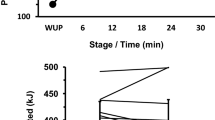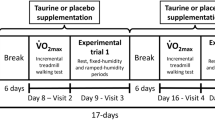Abstract
Studies have shown that variations in ambient water vapour pressure from 1.7 to 3.7 kPa have little effect on heat tolerance time at a metabolic rate above 450 W while wearing protective clothing. With lighter exercise, where tolerance times exceed 60 min, variations in vapour pressure have a significant impact on evaporative heat loss and, therefore, heat tolerance. The present study has examined whether these findings extend to conditions with more extreme variations in vapour pressure. Twelve males performed light (L, 350 W) and heavy (H, 500 W) exercise at 40°C in a dry (D, 1.1 kPa) and humid (H, 4.8 kPa) environment while wearing a semi-permeable nuclear, biological and chemical protective clothing ensemble (0.29 m2×°C−1·W−1 or 1.88 clo; Woodcock vapour permeability coefficient,i m=0.33). Partitional calorimetry was used to determine the rate of heat storage (\(\dot S\)) with evaporative heat loss from the skin (\(\dot E_{sk} \)) calculated from changes in dressed mass or the physical properties of the clothing and the vapour pressure gradient between the skin and the environment. Skin vapour pressure was predicted from measurements of water vapour pressure above the skin surface and in the clothing with humidity sensors coupled with thermistors. Final mean skin temperature (\(\bar T\) sk) was higher for the humid trials and averaged 37.4 (0.3)°C, 38.9 (0.4)°C, 37.6 (0.5)°C and 38.5 (0.4)°C for LD, LH, HD and HH, respectively. Final rectal temperature (T re ) was higher for D with respective values for LD, LH, HD and HH of 39.0 (0.4)°C, 38.7 (0.4)°C, 38.8 (0.4)°C and 38.5 (0.4)°C. Tolerance time was significantly different among the trials and averaged 120.3 (19.3) min, 54.8 (7.3) min, 63.5 (6.9) min and 36.8 (3.1) min for LD, LH, HD and HH, respectively.\(\dot E_{sk} \) was overestimated and, therefore,\(\dot S\) was underestimated when the changes in dressed mass were used to determine evaporative heat loss. When skin vapour pressure determined from the humidity sensor data was used to calculate\(\dot E_{sk} \), heat storage was significantly different among the trials and averaged 15.0 (3.0), 13.0 (1.8), 14.2 (2.6) and 12.2 (1.9) kJ·kg−1 for LD, LH, HD and HH, respectively. It was concluded that while wearing the protective clothing all indices of heat strain, including tolerance time, were significantly affected by the change in ambient water vapour pressure from 1.1 to 4.8 kPa during both light and heavy exercise.
Similar content being viewed by others
References
Aoyagi Y, McLellan TM, Shephard RJ (1994) Effects of training and acclimation on heat tolerance in exercising men wearing protective clothing. Eur J Appl Physiol 68:234–245
Aoyagi Y, McLellan TM, Shephard RJ (1995a) Effects of 6 versus 12 days of heat acclimation on heat tolerance in lightly exercising men wearing protective clothing. Eur J Appl Physiol 71:187–196
Aoyagi Y, McLellan TM, Shephard RJ (1995b) Determination of body heat storage in clothing: calorimetry versus thermometry. Eur J Appl Physiol 71:197–206
Burton AC (1935) Human calorimetry J Nutr 9:261–280
Carter BJ, Cammermyer M (1985) Emergence of real casualties during simulated chemical warfare training under high heat conditions. Mil Med 150:657–665
Cotter JD, Patterson MJ, Taylor NAS (1995) The topography of eccrine sweating in humans during exercise. Eur J Appl Physiol 71:549–554
Craig FN, Moffitt JT (1974) Efficiency of evaporative cooling from wet clothing. J Appl Physiol 36:313–316
Craig FN, Garren HW, Frankel H, Blevins WV (1954) Heat load and voluntary tolerance time. J Appl Physiol 6:634–644
Danielsson U (1993) Convection coefficients in clothing air layers. Doctoral Thesis, The Royal Institute of Technology, Stockholm
Givoni B, Goldman RF (1972) Predicting rectal temperature response to work, environment, and clothing. J Appl Physiol 32:812–822
Goldman RF, Green EB, Iampietro PF (1965) Tolerance of hot, wet environments by resting men. J Appl Physiol 20:271–277
Gonzalez RR, Cena K (1985) Evaluation of vapor permeation through garments during exercise. J Appl Physiol 58:928–935
Gonzalez RR, Levell CA, Stroschein LA, Gonzalez JA, Pandolf KB (1993) Copper manikin and heat strain model evaluations of chemical protective ensembles for the technical cooperation program (TTCP). US Army Research Institute of Environmental Medicine, Technical Report No. T94-4
Hardy JD, Stolwijk JAJ (1966) Partitional calorimetry studies of man during exposures to thermal transients. J Appl Physiol 21:1799–1806
Henane RJ, Bittel J, Viret R, Morino S (1979) Thermal strain resulting from protective clothing of an armored vehicle crew in warm conditions. Aviat Space Environ Med 50:599–603
Hody GL (1973) The field measurement of cold stress in the marine environment. Defence and Civil Institute of Environmental Medicine Consultant Report, North York, Canada
Kakitsuba N, Gaul K, Michna M, Mekjavic IB (1988) Dynamic moisture permeation through clothing. Aviat Space Environ Med 59:49–53
Kaufmann WC (1963) Human tolerance limits for some thermal environments of Aerospace. Aerosp Med 34:889–896
Livingstone SD, Nolan RW, Cain JB, Keefe AA (1994) Effect of working in hot environments on respiratory air temperatures. Eur J Appl Physiol 69:98–101
McLellan TM (1993) Work performance at 40°C with Canadian Forces biological and chemical protective clothing. Aviat Space Environ Med 64:1094–1100
McLellan TM, Meunier P, Livingstone SD (1992) Influence of a new vapour protective clothing layer on physical work tolerance times at 40°C. Aviat Space Environ Med 63:107–113
McLellan TM, Jacobs I, Bain JB (1993) Influence of temperature and metabolic rate on work performance in Canadian Forces NBC clothing. Aviat Space Environ Med 64:587–594
McLellan TM, Cheung SS, Jacobs I (1995) Variability of time to exhaustion during submaximal exercise. Can J Appl Physiol 20:39–51
Mitchell JW, Nadel ER, Stolwijk JAJ (1972) Respiratory weight losses during exercise. J Appl Physiol 32:474–476
Montain SJ, Sawka MN, Cadarette BS, Quigley MD, McKay JM (1994) Physiological tolerance to uncompensable heat stress: effects of exercise intensity, protective clothing, and climate. J Appl Physiol 77:216–222
Neilsen B, Neilsen M (1962) Body temperatures during work at different environmental temperatures. Acta Physiol Scand 56:120–129
Nishi Y (1981) Measurement of thermal balance of man. In: Cena K, Clark JA (eds) Bioengineering, thermal physiology and comfort. Elsevier, New York, pp 29–39
Nunneley SA (1989) Heat stress in protective clothing. Interactions among physical and physiological factors. Scand J Work Environ Health 15 [Suppl 1]:52–57
Nunneley SA, Antunano MJ, Bomalaski SH (1992) Thermal convergence fails to predict heat tolerance limits. Aviat Space Environ Med 63:886–890
Pandolf KB, Goldman RF (1978) Convergence of skin and rectal temperature as a criterion for heat tolerance. Aviat Space Environ Med 49:1095–1101
Pandolf KB, Stroschein LA, Drolet LL, Gonzalez RR, Sawka MN (1986) Prediction modeling of physiological responses and human performance in the heat. Comput Biol Med 16:319–329
Shvartz E, Benor D (1972) Heat strain in hot and humid environments. Aerosp Med. 43:852–855
Shvartz E, Glick Z, Magazanik A (1977) Responses to temperate, cold and hot environments and the effect of physical training. Aviat Space Environ Med 48:254–260
Snellen JW (1966) Mean body temperature and the control of thermal sweating. Acta Physiol Pharmacol Neerl 14:99–174
Vallerand Al, Savourey G, Hanniquet A-M, Bittel JHM (1992) How should body heat storage be determined in humans: by thermometry or calorimetry? Eur J Appl Physiol 65:286–294
Van Beest CA, Wittgen PPMM (1986) A simple apparatus to measure water vapour resistance of textiles. Text Res J 57:566–568
Author information
Authors and Affiliations
Rights and permissions
About this article
Cite this article
McLellan, T.M., Pope, J.I., Cain, J.B. et al. Effects of metabolic rate and ambient vapour pressure on heat strain in protective clothing. Europ. J. Appl. Physiol. 74, 518–527 (1996). https://doi.org/10.1007/BF02376767
Accepted:
Issue Date:
DOI: https://doi.org/10.1007/BF02376767




